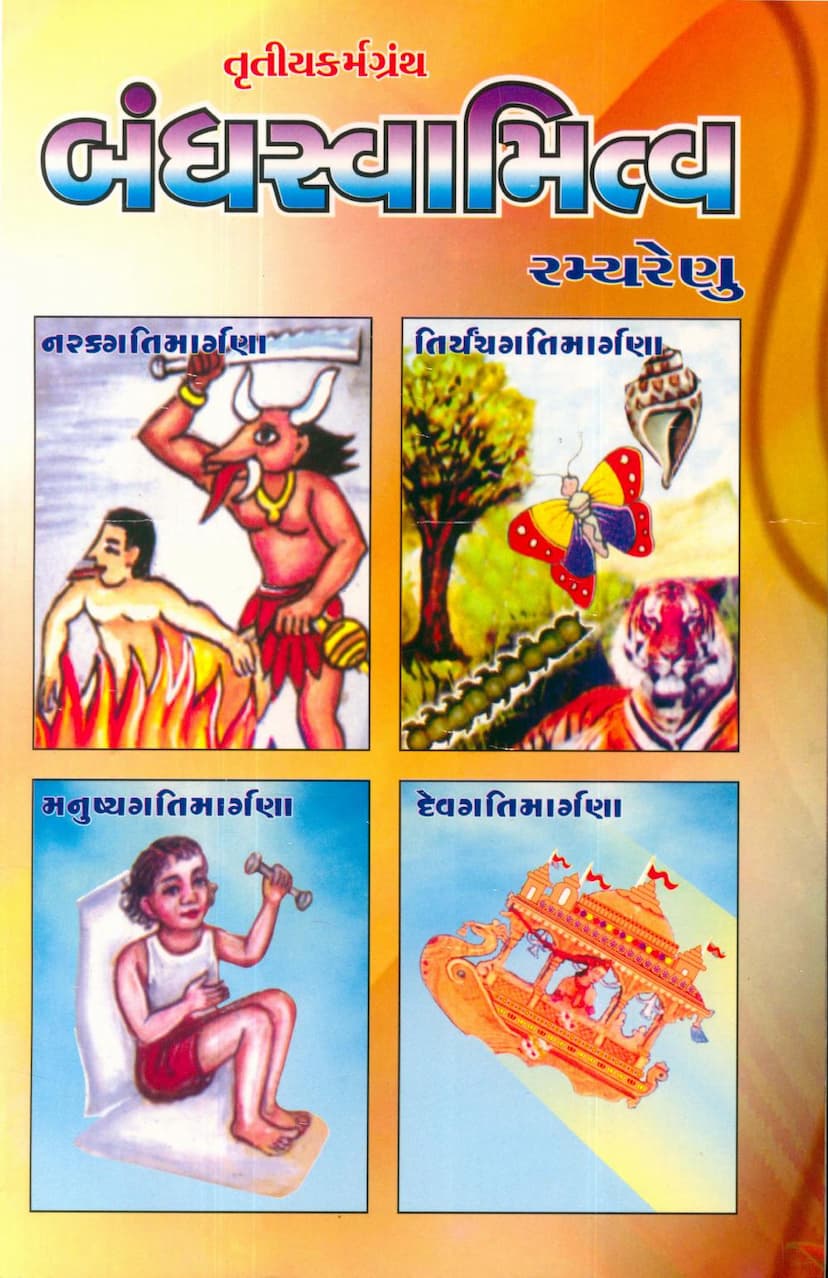Bandhswamitva Tritiya Karmgranth
Added to library: September 1, 2025

Summary
The book "Bandhswamitva Tritiya Karmgranth" by Ramyarenu, published by Rander Road Jain Sangh, is a profound exploration of Jain karmic philosophy, specifically focusing on the concepts of "Bandhswamitva" (ownership of bondage) and "Uday-Udirana" (manifestation and eruption of karma).
Core Concepts and Structure:
The text delves deeply into the intricate workings of karma as understood in Jainism. It systematically analyzes how different karmic bonds manifest and are experienced by souls across various "margaṇās" (categories or pathways of existence) and "guṇasthānas" (stages of spiritual development).
Key Themes and Content:
-
Bandhswamitva (Ownership of Bondage): The primary focus is on understanding which soul in which specific "margaṇā" (e.g., different types of births like hellish beings, animals, humans, or celestial beings; different sensory faculties; different types of bodies, mind, speech, etc.) and in which "guṇasthāna" can bind which specific karmic "prakṛti" (type of karma). The text details the specific karmas that can be bound, or are prevented from being bound, at each stage.
-
Uday-Udirana (Manifestation and Eruption): The latter part of the text, attributed to Acharya Shri Vīrśekhar Sūri Mahārāja, shifts focus to "Uday-Udirana." This explores how the karmas that have been bound (Bandh) actually manifest and erupt in a soul's experience. It analyzes the specific karmas that manifest ("Uday") and those that erupt prematurely or in a different manner than expected ("Udirana") in different margaṇās and guṇasthānas.
-
Margaṇās and Guṇasthānas: The book is meticulously structured around the 62 "margaṇās," which are classifications of souls based on various characteristics like senses, body types, mind, speech, passions, knowledge, conduct, lifespan, etc. For each margaṇā, it systematically analyzes the karmic bondage and manifestation across the 14 "guṇasthānas," which represent the progressive spiritual development of a soul.
-
Detailed Analysis: The text provides a highly detailed, quantitative analysis of which specific karmic "prakṛtis" (out of the 148 or 122 types of karma) are bound, manifest, or erupt in each of the 62 margaṇās and across the 14 guṇasthānas. This involves intricate calculations and cross-referencing between different classifications.
-
Interconnectedness of Karmic Principles: The book highlights the interconnectedness of the various principles of karma – Bandh (bonding), Uday (manifestation), and Udirana (eruption). It shows how the soul's state (guṇasthāna) and its category of existence (margaṇā) directly influence these karmic processes.
-
Authorship and Lineage: The text acknowledges the original work on "Bandhswamitva" by Acharya Shri Devendra Sūri Mahārāja and the commentary on "Uday-Udirana" by Acharya Shri Vīrśekhar Sūri Mahārāja. The authorship of the presented work is by Sadhvī Shri Harṣguṇāshrijī M., a disciple of Pujya Sa. Shri RamyaGuṇāshrijī M., herself a disciple of Acharya Shri Kailassagar Sūri. The publication is by Shri Rander Road Jain Sangh, Surat. The text also includes dedications and acknowledgments to various spiritual gurus and patrons, indicating a strong lineage and community support for Jain knowledge dissemination.
-
Appendices and Visual Aids: The book includes a comprehensive table of contents, detailing the specific topics covered. It also features various diagrams and charts illustrating the "margaṇās" (e.g., gati, indriya, kaya, yoga, veda, kashaya, jnana, samyama, darshan, lleshya, bhavya, samyaktva, sanjnī, ahārī). These visual aids are crucial for understanding the complex classifications and their relationship to karmic processes.
Significance and Purpose:
The "Bandhswamitva Tritiya Karmgranth" serves as an advanced text for Jain scholars and practitioners seeking a deep and systematic understanding of karma. By detailing the specific karmic consequences of a soul's state and actions across various life forms and spiritual stages, it aims to:
- Clarify the mechanics of karma: Provide a clear roadmap of how karma operates.
- Promote spiritual progress: By understanding the implications of one's actions and spiritual state on karmic bondage and manifestation, individuals can make more conscious choices to avoid negative karma and cultivate positive karma.
- Aid in scriptural study: It acts as a foundational text for understanding other Jain scriptures that discuss karma.
In essence, this work is a testament to the rigorous and analytical approach of Jain philosophy in explaining the complex causal relationships governing existence, with a particular focus on the science of karma. It is a scholarly compilation that aims to make the profound principles of Jainism accessible through detailed categorization and explanation.